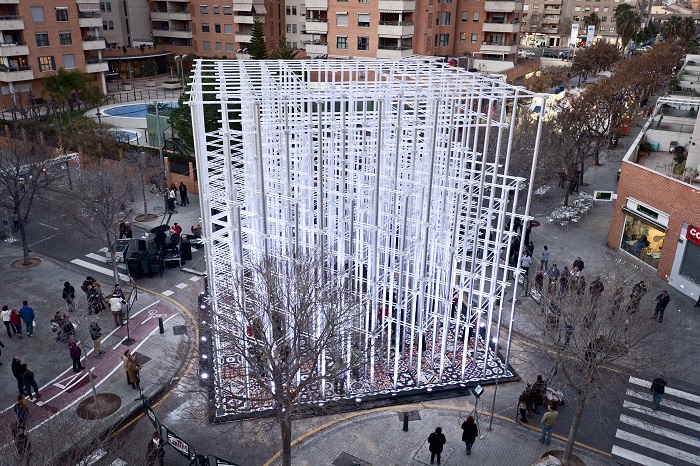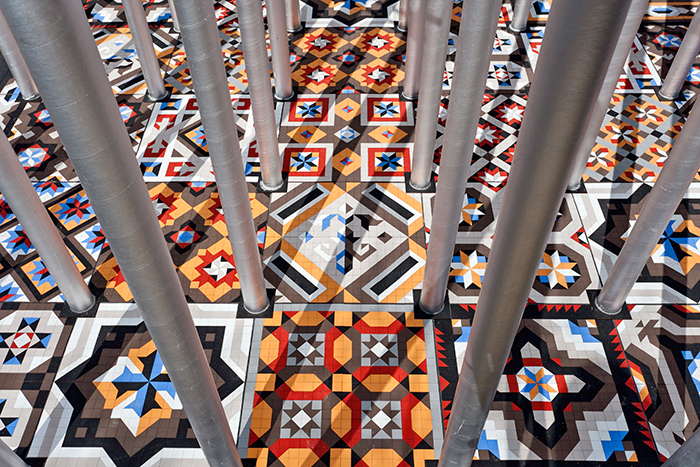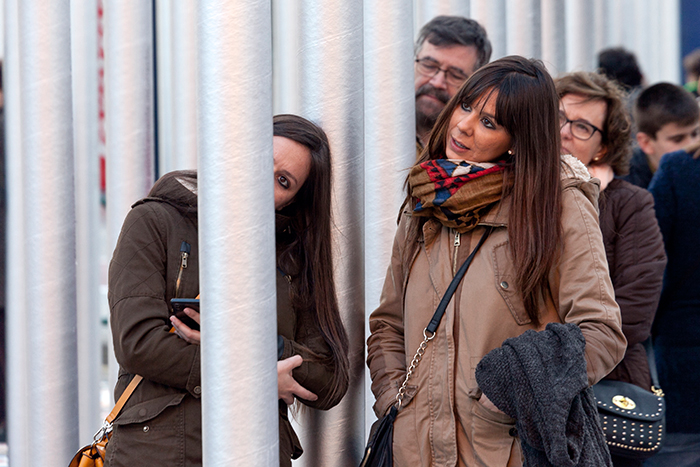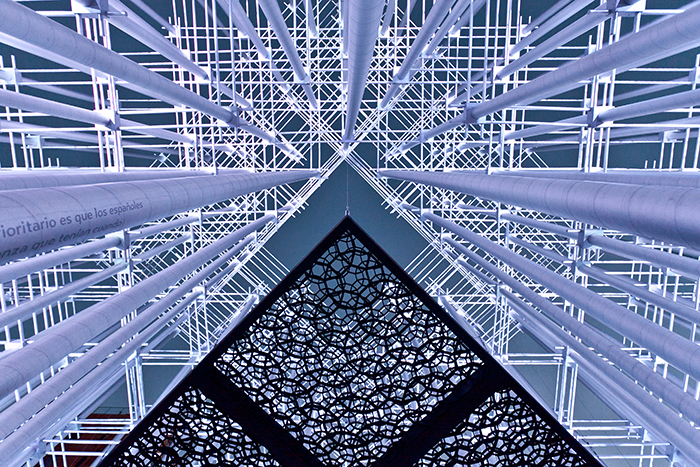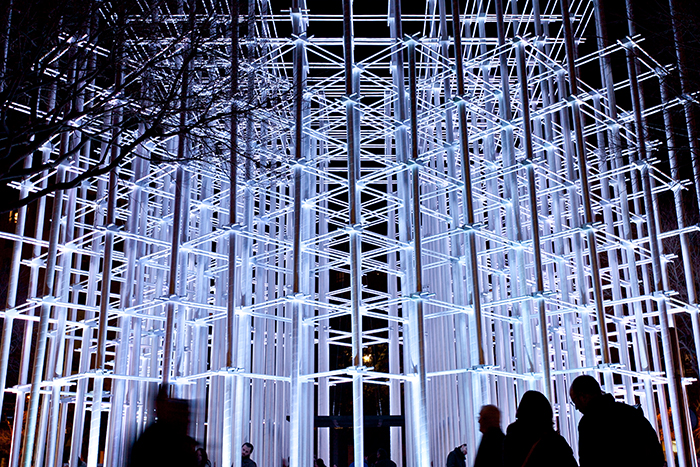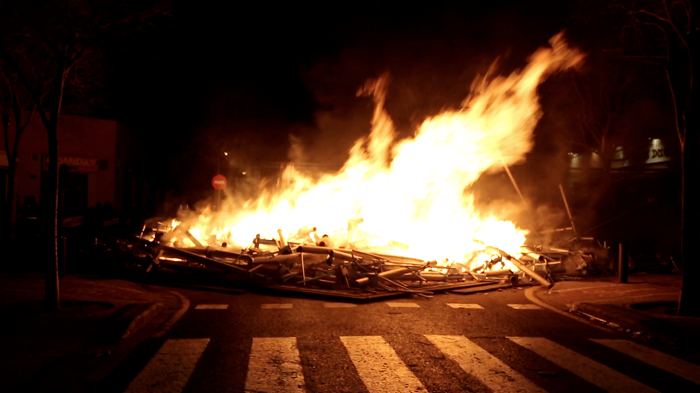By Matthew Morowitz
Ekklesía. Photo courtesy of Noel Arraiz.
Last March, the public art project Pink Intruder presented their work Ekklesía at the Fallas festival in Valencia, Spain. The name Fallas refers both to the festival, as well as the monuments that are created during the celebration. These monuments, which are created out of cardboard and paper-mâché, are erected in public spaces and burned on the final night of the festival.
Pink Intruder’s monument, Ekklesía, was “an installation made with cardboard tubes with a metallic appearance atop a mosaic made of 96,000 wooden pieces.” The mosaic is based on the designs of Nolla Mosaic, a traditional Valencian ceramic pattern, and emphasizing that “innovation in a traditional context should be based on a thorough knowledge of tradition.” Each cardboard “column” had printed on them critical political messages by the citizens. With municipal elections coming up closely following the festival, Pink Intruder wanted their piece to help feed into public debate at the time while at the same time criticizing some of the campaigns of the politicians. The entire monument thus represents this moment of history, tradition, and politics:
Ekklesía. Video courtesy of Noel Arraiz.
“The installation represented a temple where citizens can meet and realize the power they have to change things through debate and confrontation of ideas. Hence the title Ekklesia, as this was the ancient Greek assembly that met once a year between elections to decide if someone was annoying for the polis, and if that was the case expel him from the city for ten years.”
Art in Odd Places (AiOP) was able to talk with Miguel Arraiz García of Pink Intruder to gain more insight on what motivated the creation of this piece, how they went about erecting it, and what they hoped it would help accomplish.
What was the inspiration behind EKKLESÍA? Why did you choose the Fallas festival? How long was this work standing?
Context is always inspiration. We are living in a moment in Europe and Spain full of political changes, where debates about the strength of our democracy, and its quality, are very present. The concept of Ekklesia, that citizens not only vote every 4 years but have a continuous possibility of improving democracy, was something we wanted to talk about.
Ekklesía, with focus on the Nolla Mosaic. Photo courtesy of Noel Arraiz.
Fallas is a traditional festival; there are historical records of monuments being burned since 1740. So we thought that implementing this debate, and also a change, not only in the ethical part but also on the aesthetics, was a great opportunity to reach the main goal of installation, generate debate. But not an elitist debate, a debate where the whole city was participating.
These works stand in the city for only five days, and the last day, the 19th of March, they all get burned. Due to the complexity, we were working to build it in the street another ten days.
The name and part of the inspiration came from the ancient Ekklesia, an event used to ostracize potential tyrants from the polis, was there a specific person or system that you aimed this piece towards?
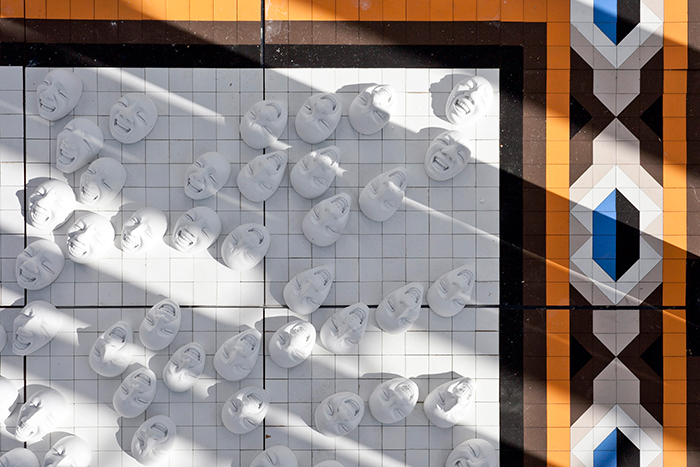
Ekklesía. Photo courtesy of Noel Arraiz.
Another particularity of the Fallas festival is that monuments are not only aesthetical, the thing they have to fulfill is that they have to be critics, with the topic each monument decides. In my understanding fallas have to be annoying for the governors, not matter who they are.
What kinds of discourse were you hoping to start from this piece? What was the public reaction?
As said before we wanted to generate debate; one of the main debates was between tradition and contemporary. There are a lot of centenarian traditions in Spain, but this one in particular has the opportunity of changing completely every year because the monuments get burned. And even through minor changes in the way monuments are built create a strong debate and confrontation. We took this debate to the limit.
The reactions were completely polarized: people or loved it or really hated it, even shouting to us while building. Even between the haters, some of them said it is really cool and nice, but this is not the place to be, this is an insult to tradition.
People interacting with the political messages of Ekklesía. Photo courtesy of Noel Arraiz.
However we knew about these reactions beforehand and played with that. All people around visiting started to debate, between those who thought things need to change, or at least you need to experiment something new and if doesn´t works you don´t repeat it, and people saying things have always been made this way no need to change. So the Ekklesia was happening right there in front of our eyes.
Why did you choose this venue in particular? Were you hoping to start commentary on Valencian/Spanish politics?
Another fact especially about the time this venue took place is that is was only 50 days before municipal elections. People were starting to debate also about politics, but using only the messages that politicians send to their supporters as a mantra. All of the columns were screen-printed with real political messages, and other not real trying to joke. Sometimes it was difficult to notice the difference between the real and fake messages.
Interior shot of Ekklesía. Photo courtesy of Noel Arraiz.
Was there any significance about the spot where you erected this piece in Valencia? Did it have any effects on public activity in that area?
Every year around 400 of this monuments (most of them classical) are settled in Valencia; every monument is paid for by private associations, it´s a kind of huge crowfunding invented two centuries ago to make art on the street. This particular spot, and association at the beginning of the 2000’s, made the biggest and more expensive monuments in the history of the festival, reaching costs of 900,000 euros, in a monument to be burned. It was the paradigm of opulence before the real estate bubble exploded; don´t know exactly how, but we convinced them to change its model, because it was a model that was nonsense in the actual time, and to us as the spearhead that will generate debate. We were not only generating debate, we were generating it from inside the association that was standing for a completely different way of understanding things.
Ekklesía at night. Photo courtesy of Noel Arraiz.
Has the success of and/or reactions to EKKLESÍA influenced/inspired any upcoming works? What are you upcoming works?
The goal was to generate an icon, so from now to the future when the debate of changes appears, someone can show the image and say, “things can be the way we want, nothing’s written beforehand.” Now some people accept that image, some don´t, but as one tradition happens every year, it passes more traditions this monument will be. So with time we will incorporate a new aesthetic to the tradition, and ethics and aesthetics always go together.
La Cremà. Photo courtesy of Noel Arraiz.

